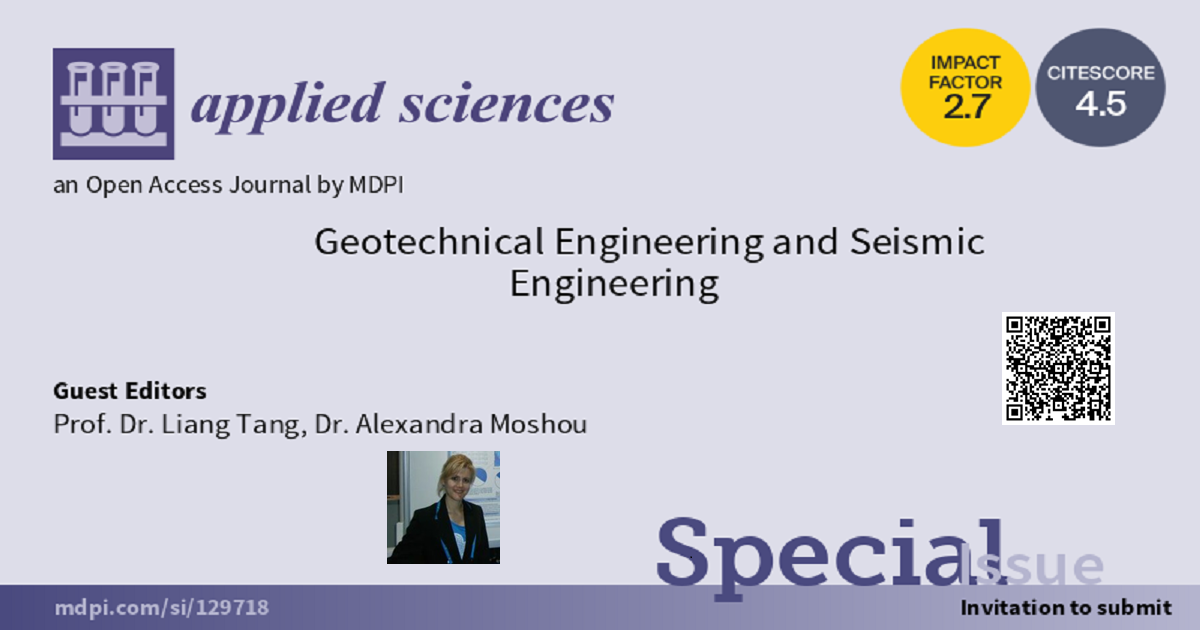Geotechnical Engineering and Seismic Engineering
A special issue of Applied Sciences (ISSN 2076-3417). This special issue belongs to the section "Earth Sciences".
Deadline for manuscript submissions: closed (31 August 2023) | Viewed by 4251

Special Issue Editors
Interests: geodynamics and geoseismic engineering; permafrost and high-speed railway roadbed engineering; transportation geotechnical engineering and subway engineering
Special Issues, Collections and Topics in MDPI journals
Interests: seismic big data; deep learning; spatial data processing; seismic data processing; earth science informatics; analysis and visualization of earth science data; seismic sequences
Special Issues, Collections and Topics in MDPI journals
Special Issue Information
Dear Colleagues,
We are inviting submissions to the Special Issue on Geotechnical Engineering and Seismic Engineering.
The seismic response of bridge pile foundation in liquefiable soils and associated failure mechanisms is one of the central issues in geotechnical engineering. The seismic response of pile foundation in liquefiable soils and associated failure mechanisms, encompassing pile-soil interaction theory, test method, basic characteristics of liquefiable site, seismic input analysis method. The failure mechanisms involving coupling of structural bending and buckling under combined lateral and vertical loading and its negative influence. A novel simplified analysis method of the seismic response of nonlinear soil-pile-structure system in liquefiable ground. New method to identify and avoid the structural failure. Improving current seismic code for designing bridges in liquefiable ground. Case studies, model and field tests, theoretical method, numerical simulation, and criterion analogy could be adopted to investigate the seismic response of pier of bridges.
In this Special Issue, we invite submissions exploring cutting-edge research and recent advances in the fields of Geotechnical Engineering and Seismic Engineering. Both theoretical and experimental studies are welcome, as well as comprehensive review and survey papers.
Prof. Dr. Liang Tang
Dr. Alexandra Moshou
Guest Editors
Manuscript Submission Information
Manuscripts should be submitted online at www.mdpi.com by registering and logging in to this website. Once you are registered, click here to go to the submission form. Manuscripts can be submitted until the deadline. All submissions that pass pre-check are peer-reviewed. Accepted papers will be published continuously in the journal (as soon as accepted) and will be listed together on the special issue website. Research articles, review articles as well as short communications are invited. For planned papers, a title and short abstract (about 100 words) can be sent to the Editorial Office for announcement on this website.
Submitted manuscripts should not have been published previously, nor be under consideration for publication elsewhere (except conference proceedings papers). All manuscripts are thoroughly refereed through a single-blind peer-review process. A guide for authors and other relevant information for submission of manuscripts is available on the Instructions for Authors page. Applied Sciences is an international peer-reviewed open access semimonthly journal published by MDPI.
Please visit the Instructions for Authors page before submitting a manuscript. The Article Processing Charge (APC) for publication in this open access journal is 2400 CHF (Swiss Francs). Submitted papers should be well formatted and use good English. Authors may use MDPI's English editing service prior to publication or during author revisions.
Keywords
- liquefaction
- seismic response
- dynamic pile-soil-structure interaction
- simplified analysis method
Benefits of Publishing in a Special Issue
- Ease of navigation: Grouping papers by topic helps scholars navigate broad scope journals more efficiently.
- Greater discoverability: Special Issues support the reach and impact of scientific research. Articles in Special Issues are more discoverable and cited more frequently.
- Expansion of research network: Special Issues facilitate connections among authors, fostering scientific collaborations.
- External promotion: Articles in Special Issues are often promoted through the journal's social media, increasing their visibility.
- e-Book format: Special Issues with more than 10 articles can be published as dedicated e-books, ensuring wide and rapid dissemination.
Further information on MDPI's Special Issue polices can be found here.






